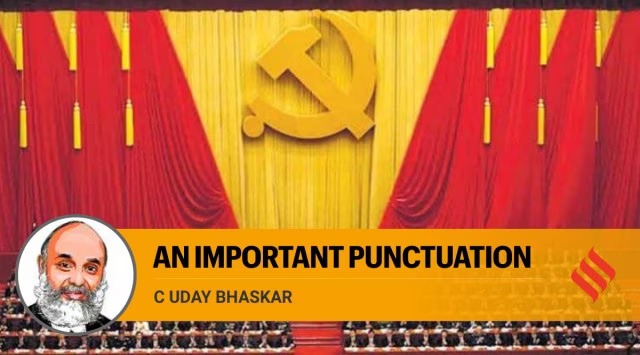Under Beijing's Shadow
THE INDIAN EXPRESS
APLN member C Raja Mohan writes on the unfolding China-US conflict and it’s implications for Asia and the Indo-Pacific. Read the original article here.
Indian and American policies are converging. For both Delhi and Washington, Beijing presents the main national challenges. The current churn offers a promising opportunity for collaboration.
America’s national security strategy issued by the Joe Biden Administration last week and the Chinese Communist Party’s 20th Congress this week promise to reshape the geopolitics of Asia and the Indo-Pacific. The US NSS has affirmed that China remains its greatest threat. The CCP this week is likely to double down on Xi Jinping’s muscular quest to replace the US as the dominant power in Asia. As prospects for limiting the Sino-US conflict recede, India and the rest of Asia must adapt to the systemic changes that it is likely to produce.
Asia has seen multiple phases in the US-China relationship. In the second half of the 19th century, American missionaries began to arrive in China and began to generate empathy for the nation. During World War II, Washington backed Chinese nationalists in their fight against Japanese occupation. The US tried to isolate China from 1949 when the communists prevailed over the nationalists. The 1970s saw the US and communist China come together to counter the Soviet Union. The 1980s saw the beginning of an economic engagement that turned into a huge commercial and technological partnership from the 1990s. At the turn of the 21st century, some in the US began to see China as a potential threat. But the US establishment dismissed the idea and bet that Beijing could become a “responsible stakeholder” in the world order. America also believed that China’s growing economic prosperity would inevitably lead to greater democratisation of its society.
China, however, has steadily moved in the other direction, especially under Xi, who has convinced himself that the West is in terminal decline.
Xi is determined to seize this moment to reshape the Asian as well as the global order to suit Chinese interests. At the same time, China has become increasingly repressive at home. Xi made no effort to hide China’s new geopolitical ambition nor has he been defensive about his authoritarian rule. This, in turn, bestirred the US into rethinking its China policy in the second decade of the 21st century. The traditional soft attitude to China yielded to a more confrontational approach during the Donald Trump presidency. Joe Biden has developed that into a more structured policy of competing with China. The National Security Strategy of the Trump administration postulated the return of great power rivalry and the need to respond to the challenges presented by Russia and China. Biden’s NSS builds on that proposition and identifies China as the more demanding challenge than Russia, despite Moscow’s aggression against Ukraine.
In his foreword to the NSS, Biden says “Russia poses an immediate threat to the free and open international system, recklessly flouting the basic laws of the international order today, as its brutal war of aggression against Ukraine has shown.” He names China, on the other hand, as “the only country with both the intent to reshape the international order and, increasingly, the economic, diplomatic, military and technological power to advance that objective”. While the European challenge is real, the Biden Administration now sees the Indo-Pacific as the principal strategic theatre. In the second half of the 20th century, Asia was secondary to the Cold War in Europe. Today, it is the primary focus for the US in its confrontation with China.
Seen from the regional perspective, the unfolding contest between the US and China will now be the principal factor shaping international relations of Asia and the Indo-Pacific. India and the rest of Asia must now engage with at least three dimensions of the Sino-US conflict.
The first is ideological. The US has sought to locate the conflict with China (and Russia) as a fundamental struggle between “democracies and autocracies”. Recognising the limited enthusiasm for the framing in Asia, the NSS now talks of broadening the coalition to include countries that may not be democratic. Beijing, on the other hand, argues that recent history points to the superiority of the Chinese system over the Western one. And it offers its own versions of a global order – economic, political and social. Since the end of the Cold War, ideological arguments had receded into the background but are now back in significant play.
Second is on the trade and technological front. China continues to sing praises of the model of economic globalisation that has facilitated Beijing’s rise over the last four decades. But under Xi, China has emphasised the importance of self-reliance — in the name of a “dual circulation strategy”. In the past, China’s focus was on the globalisation of its economy. Now, there is a greater emphasis on internal economic dynamism and reducing the reliance on foreign technologies. At the same time, Beijing has sought to enhance the world’s dependence on its economy and leverage it for strategic benefit. The profound political backlash against trade and economic cooperation with China in the US led to the questioning of economic globalisation in the Trump years.
Reflecting the political consensus in the US, Biden’s NSS now says the US will “look beyond” the traditional free trade agreements and make major “adjustments” to the old model of globalisation. Driving this adaptation are growing domestic inequality, the China challenge, and the role of new technologies. As part of its effort to outcompete China, the US has imposed a series of technology sanctions against China and has turned to the once taboo “industrial policy” to strengthen internal innovation.
The third area is the future of alliances in Asia. As China became a richer country, it also focused on building a powerful army. Using both the instruments of hard power, China under Xi has actively sought to undermine US alliances in Asia and mount pressure on American forward military presence in Asia. The US is now pushing back. The principal instrument in the US response has been rebuilding the traditional bilateral alliances with Japan and Australia as well as constructing new partnerships with countries like India and developing new regional coalitions. India’s engagement with the US-China dynamic has not been an uncomfortable one in the past. When the US sought to isolate China in the 1950s, India tried to befriend it and promote its international acceptance. When the US and China joined to limit Soviet power in the 1970s, Delhi deepened its alliance with Moscow. India watched with envy as the US helped the rapid modernisation of the Chinese economy. Today, Indian and American policies are converging. For both Delhi and Washington, Beijing presents the main national challenges. On the economic and technological front, both India and the US are trying to reduce their exposure to China. On the geopolitical front, a US plan to look beyond formal alliances suits Delhi, which is wedded to an independent foreign policy.
It is never easy to translate abstract convergence into concrete policies. The current churn in Asia provides Delhi and Washington with a historic opportunity to build on the new convergences in the areas of trade, technology, and geopolitics.




